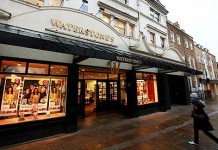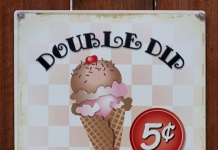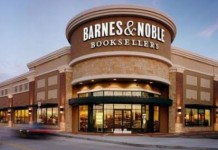 I was in midtown NYC earlier today when I stopped to have a coffee and catch up on my RSS feeds, and I saw a couple of blog references to a video of the Espresso Book Machine (EBM) posted over on NPR’s Science Friday blog. The video is a short, lighthearted overview of an EBM that was installed about a month ago at McNally Jackson Books here in Manhattan.
I was in midtown NYC earlier today when I stopped to have a coffee and catch up on my RSS feeds, and I saw a couple of blog references to a video of the Espresso Book Machine (EBM) posted over on NPR’s Science Friday blog. The video is a short, lighthearted overview of an EBM that was installed about a month ago at McNally Jackson Books here in Manhattan.
I’ve wanted to see one of these machines up close for a while now, but I had no idea that a local indie bookstore had one. So I finished my coffee, hopped on the subway, and went to buy myself a print-on-demand book.
There’s not much I can write about the inner workings of the “big fancy robot,” as one of McNally Jackson’s employees calls it in the NPR video. It’s essentially three machines stacked together: a Xerox copier to handle the initial paper management; the custom plexiglass, steel, and blade contraption that handles the collating, binding and cutting; and a small color printer to handle the covers. (The interior pages are black and white only.)

Because this was an impulse trip, I hadn’t taken the time to scour Google Books for just the right awesome public domain title, so I had to settle for something I could find quickly that I knew wouldn’t otherwise be available in print. I chose“Jonestown Survivor,” a 2010 memoir self-published by a People’s Temple member who did not die in the mass suicide in 1978. It cost $16.95, the same as the online price at iUniverse. (The ebook edition was $9.99, grr.)
It took about fifteen minutes to print the book, although it appears that under ideal circumstances it would take less than ten: a minute to find the book through the EBM’s control panel, another minute to download the file, one more to adjust the paper, and then about five minutes to print, cut and glue the thing. You can hear and see the book coming together page by page through the plexiglass, and you can smell the glue as it’s heated up and applied to the spine. It’s sort of like a Build-A-Bear for grownups and/or nerds.

My copy came out with an off-centered spine. The operator, who after a month seemed to know the machine’s subtle inner workings the way a mechanic knows cars, said he’d realized that the alignment was off after the machine was too far in the process to stop it. He offered to toss it out and print a perfect version at no extra cost — in fact he encouraged me to demand this, which is one of those nice customer service touches that I think indie bookstores are good at providing — but I sort of like my book’s messed-up spine. It reminded me that this is a new application of technology, and customized sometimes means imperfect. (It also seemed too wasteful to reprint what was essentially an impulse purchase.)


He went on to say that the problem wasn’t with the file. Although the original manuscripts that customers bring in sometimes require lots of adjustments, the ones pre-formatted for the EBM by publishers are usually in good shape. In this case, the problem was that someone else had adjusted the machine since its last use, and he didn’t see this until after he’d started my book. To the person who prints the next book after mine and gets a perfect spine: you’re welcome!
I asked a bunch of questions about the size limits of the EBM, but rather than paraphrase them here I should just point you to the official FAQ, which has actual numbers. He said he’s printed stuff as short as 30 pages or so, or “essentially a pamphlet,” as well as incredibly thick books. He said Google Book scans in particular were all over the place in terms of size because of the wide range and age of the collection.

I’ll probably go back and do it again, simply because of how satisfying it is to have a print-on-demand book made in such an astonishingly short period of time. (If you called ahead, it would seem even more magical.) I think next time, however, I’ll print some old, public domain book that Google has scanned. I noticed all the sample Google Book editions had a generic text-only cover; the employee said it was possible to add your own cover (of something also in the public domain, of course) to your Google Book edition and bring it in for printing, but you’ll have to pay a $10 set-up fee.
If I ran a writing workshop in NYC, and especially if I ran one for kids, I think the workshop would end with me going to McNally Jackson and printing a very short run of an anthology of the stories created in the workshop. Aside from out-of-print and on-demand titles, that kind of personal customization seems just right for something like this.
Via Chris Walters BookSprung blog


































Thanks much for the personal description. There was a legal dispute a few years back between the makers of this machine and Amazon/Ingram over claims that LightningSource was violating yet another stupid patent issued by our USPTO. We should never have begun to allow business methods patents.
Fortunately, it was settle amiably. The two technologies don’t really clash. Lighting Source uses large, expensive machines operated in a quality-controlled production environment. If demand for a book suddenly explodes, they can even shift in a matter of hours to printing on high-speed web presses. In contrast, the Expresso machines offer speed and convenience. Smaller and cheaper, with most maintenance done by staff who have other primary jobs, the machines won’t match the quality of Lightning Source’s POD books. But they’re likely to be good enough for most in-a-hurry customers. I just worry that the machines give giant chains and large big-city independents yet another advantage over small bookstores.
Is anyone else seeing the images in this article ? I have tried four browsers to no avail.
@Howard – if the images still aren’t showing up for you, click through to the original post on my blog to see them (link is at end of post).
The images seem to come and go. Don’t understand why. Check Chris’ blog for them.
This machine and the whole process looks brilliant. It is surely the future. With mass production the price will drop and the process become more streamlined. I see no reason why small-medium sized stores can not have these in a few years and contrary to Michael’s take, in my view large bookstores will be in for a hiding.
This is a great post! Thanks for sharing this experience, including the photos.
Howard – the beauty of this device is that small/medium sized stores don’t have to wait a few more years, the technology is available immediately and the sales process to bring one of these in-house through Xerox (disclaimer: I work for Xerox) is easier than ever. Check out how the Harvard Book Store is using the device in this article http://bit.ly/hEnu3s.
Chris,
Great job in summerizing the value the EBM brings to the market. It is not a printer but rather a way for Bricks and Mortar to create a unique and high value customer expereince for content that can not be found and or delivered as quickly and at a comperative value. When you add Self Publishing to the mix this becomes a powerful new Business Growth opportuinty for the bricks and mortar Bookstore.